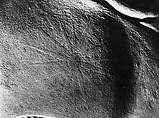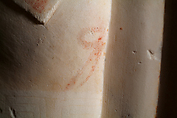Returned to lender The Met accepts temporary loans of art both for short-term exhibitions and for long-term display in its galleries.
Reconstruction of the marble funerary stele of Aristion, Variant B
Vinzenz Brinkmann German
Ulrike Koch-Brinkmann
Not on view
The reconstruction of a marble Greek funerary relief shows how the armor was decorated in paint. A large star on the shoulder, a lion’s head on the breast flap, and meander and zigzag patterns on the cuirass are all visible on the original when viewed in ultraviolet and raking light. Analyses have identified red pigment in the background, blue on the armor, and brown on the facial skin. The helmet and genitals were separate pieces that are now lost.
"This relief was set up about 510 B.C. on the tomb of an aristocrat named Aristion from the vicinity of Athens. The figure is depicted wearing a splendid suit of armor, and inscriptions give his name and that of the sculptor, Aristokles. His heavy leather cuirass was decorated in paint: ultraviolet and raking light revealed a large star pattern on the shoulder and a lion's head on the lappet of the cuirass, as well as bands of meander and zig-zag patterns. Small crosses and a finely painted border decorate the soft fabric of the undergarment.
Several colors are preserved on the relief: red for the background, blue and green for the patterns on the armor, and brown for the flesh of the face. The reconstruction is also based on the polychromy found on similar monuments, for example the blue greaves seen on other stelae. The helmet was fashioned separately and then mounted on the head. Likewise, the genitals were made from a separate piece of marble or possibly of metal."
Vinzenz Brinkmann and Ulrike Koch-Brinkmann
Reconstruction Variant B, 2005/2012:
Vinzenz Brinkmann and Ulrike Koch-Brinkmann
plaster cast and natural pigments in egg tempera; cast: Royal Cast Collection, Copenhagen. Andreas Hickel assisted in the application of paint.
Liebieghaus Skulpturensammlung (Liebieghaus Polychromy Research Project), Frankfurt am Main, inv. St.P 694
Scientific methods employed:
Ultraviolet-induced visible luminescence imaging (UVL) (Schott KV 418)
Ultraviolet-reflected imaging (UVR) (Schott UG1 or Schott BG12)
Optical stereoscopic microscopy (10–50x, Zeiss and Olympus)
Visible-reflected imaging (VIS)
Visible-reflected imaging in color (VIS)
Raking light imaging (Schott KL1500)
Photomicrograph (with microscope or macro objectives)
Scientific evaluation:
Vinzenz Brinkmann, Ulrike Koch-Brinkmann
Pigments used for the reconstruction:
blue: Egyptian blue; red: cinnabar, red ocher; green: malachite; yellow: gold ocher, calcite; flesh tones: rose madder, brown ocher, polished chalk
Acknowledgements:
National Archaeological Museum, Athens
Due to rights restrictions, this image cannot be enlarged, viewed at full screen, or downloaded.
This artwork is meant to be viewed from right to left. Scroll left to view more.













